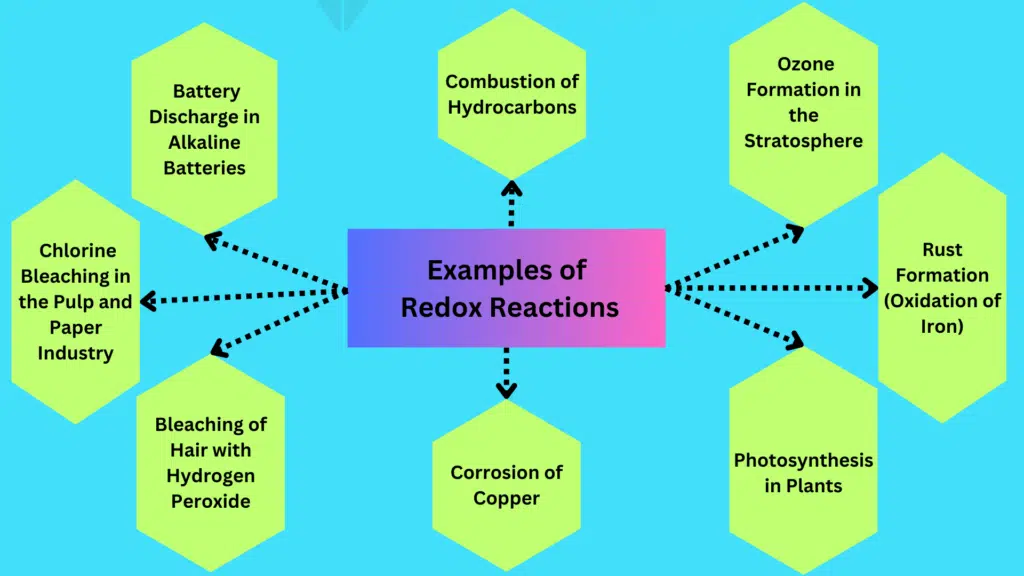10 Examples of Redox Reactions
Redox reactions, short for reduction-oxidation reactions, involve the transfer of electrons between chemical species. These reactions are fundamental in chemistry, and crucial in various natural and synthetic processes.
In this article, we’ll examine 10 different examples of redox reactions. or calculations related to redox reactions, check out the Redox Reaction Calculator.
Examples of Redox Reactions
Here are 10 Examples of Redox Reactions:

1. Combustion of Hydrocarbons
The combustion of hydrocarbons, such as the burning of methane (CH₄), is a classic example of a redox reaction. In this process, carbon undergoes oxidation, forming carbon dioxide (CO₂), while hydrogen is reduced, forming water (H₂O). This reaction’s energy release is harnessed for heating and energy production.
2. Rust Formation (Oxidation of Iron)
The rusting of iron (Fe) is a well-known redox reaction. Iron undergoes oxidation, forming iron(III) oxide (Fe₂O₃). This process is a common example of corrosion and showcases the role of oxygen in promoting oxidation reactions.
3. Photosynthesis in Plants
Photosynthesis is a complex biological redox reaction where carbon dioxide (CO₂) is reduced to glucose (C₆H₁₂O₆) using sunlight. In this process, water is oxidized, releasing oxygen (O₂) as a byproduct. Photosynthesis is vital for the energy balance in ecosystems.
4. Bleaching of Hair with Hydrogen Peroxide
The bleaching of hair with hydrogen peroxide (H₂O₂) involves a redox reaction. Hydrogen peroxide acts as an oxidizing agent, releasing oxygen and oxidizing pigments in the hair. The color change is a result of this oxidation process.
5. Corrosion of Copper
The corrosion of copper is an example of a redox reaction where copper undergoes oxidation to form copper(II) ions (Cu²⁺). This process is evident in the greenish patina that forms on copper surfaces exposed to air and moisture.
6. Chlorine Bleaching in the Pulp and Paper Industry
In the pulp and paper industry, chlorine gas (Cl₂) is often used for bleaching. Chlorine acts as an oxidizing agent, breaking down color-causing compounds through redox reactions, resulting in the whitening of paper products.
7. Electroplating with Silver
Electroplating involves redox reactions, such as the electroplating of silver onto an object. Silver ions (Ag⁺) are reduced and deposited onto the object, while another metal, often copper, undergoes oxidation to release electrons.
8. Battery Discharge in Alkaline Batteries
The discharge of alkaline batteries is a redox reaction where zinc undergoes oxidation and manganese dioxide undergoes reduction. This flow of electrons provides electrical energy for powering devices.
9. Fermentation in the Production of Ethanol
Fermentation is a biological redox reaction involving the conversion of sugars into ethanol. In this process, sugars are oxidized to produce carbon dioxide and water, while the yeast involved in fermentation is reduced, yielding ethanol.
10. Ozone Formation in the Stratosphere
In the stratosphere, the formation of ozone (O₃) is a redox reaction driven by ultraviolet (UV) radiation. Oxygen molecules (O₂) are broken down into oxygen atoms, which then combine with other oxygen molecules to form ozone.




Leave a Reply